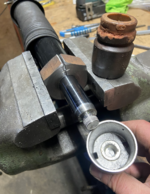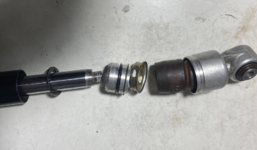In other news: I sent Martin a damaged 500E SLS strut for analysis and R&D. He's currently investigating what can be done. Right now I believe he's trying to determine how to separate the main shaft from the lower housing that contains the spherical joint. This is needed to replace the foam stop buffer.
Based on what Martin has discovered so far, I am 99.44% certain that any company claiming to "rebuild" these, are doing nothing but applying paint, installing an aftermarket accordion boot, and (in some cases) replacing the spherical joint with a rubber bushing.

Update from Martin below on the potential for proper SLS hydroleg repair. Note his request for an additional failed strut. If anyone has an old, defective SLS hydroleg they would be willing to donate so Martin can continue his forensic analysis, please let me know and I'll connect you with Martin. In particular, he'd like a strut with a failed lower joint. The bad hydroleg I sent him had a good lower joint, and he'd prefer not to destroy a good one.
"I am doing my first sketches and the design is becoming clearer.
I cannot pull the piston out of the tube right now. I guess there must be a second retainer further back that is not allowing me to move the piston shaft out of the tube. The second retainer must be accessible for disassembly. One way would be to disconnect the bottom joint from the piston shaft, so I can move the piston seal out. Then I have at least a chance to remove the second retainer. Do you know if people could open that connection? I would guess that the 22mm chromed piston shaft has a threaded connection to the aluminum housing/ spherical joint. pictures are always welcome. I'll build a tool and try to remove the bottom joint from the piston shaft.
Spherical Joint: this joint is flanged into the aluminum housing. So once the flange is opened there is no good way to flange again (if we had an original
dimensioned joint). As this joint looks relatively intact I don't want to destroy the joint housing... so with a second strut that is in bad shape I'd feel much better to cut it open.
Once the joint is removed I'll see how the spherical joint is designed and we can go and hunt for a proper replacement. Still unsure if we can use the old housing again or the other (better) option is reproducing the aluminum housing and installing a new joint. Here we had a much better chance of success.
I have some good success reproducing relatively complicated geometries in China for the Mercedes 600 hydraulics. So I see a chance here. We also should reproduce the PU end stop [foam stop buffer].
I believe the repairs are possible with some effort (reproduction of bottom joint, reproduction of PU buffer, reproduction of accordion boot, reproduction
of Teflon piston seal)."









